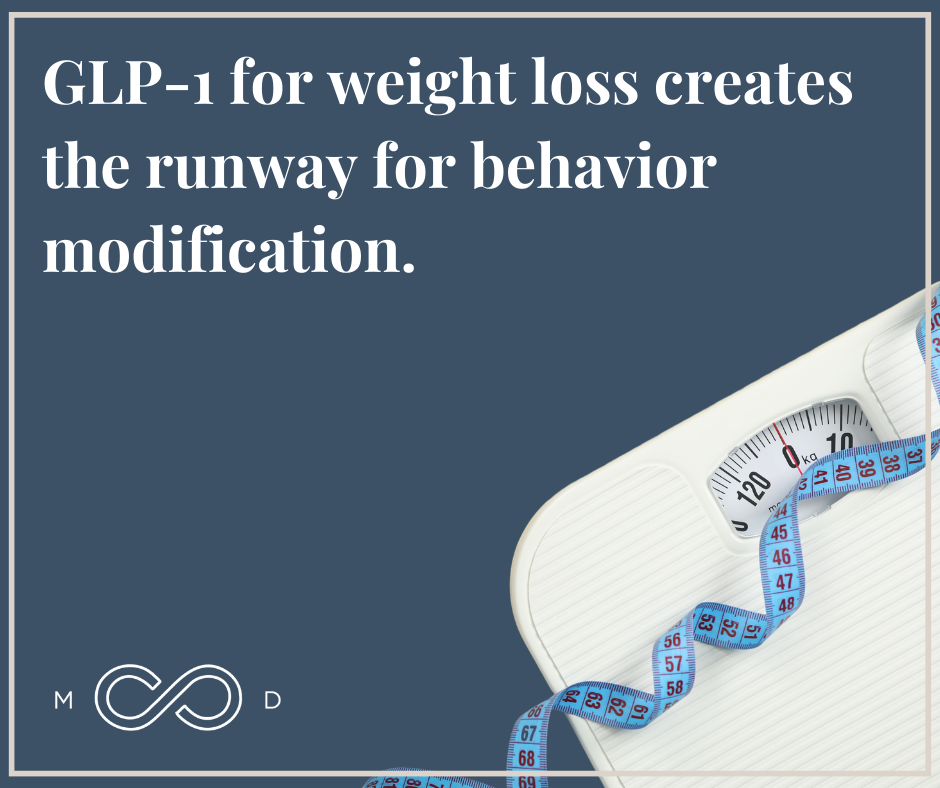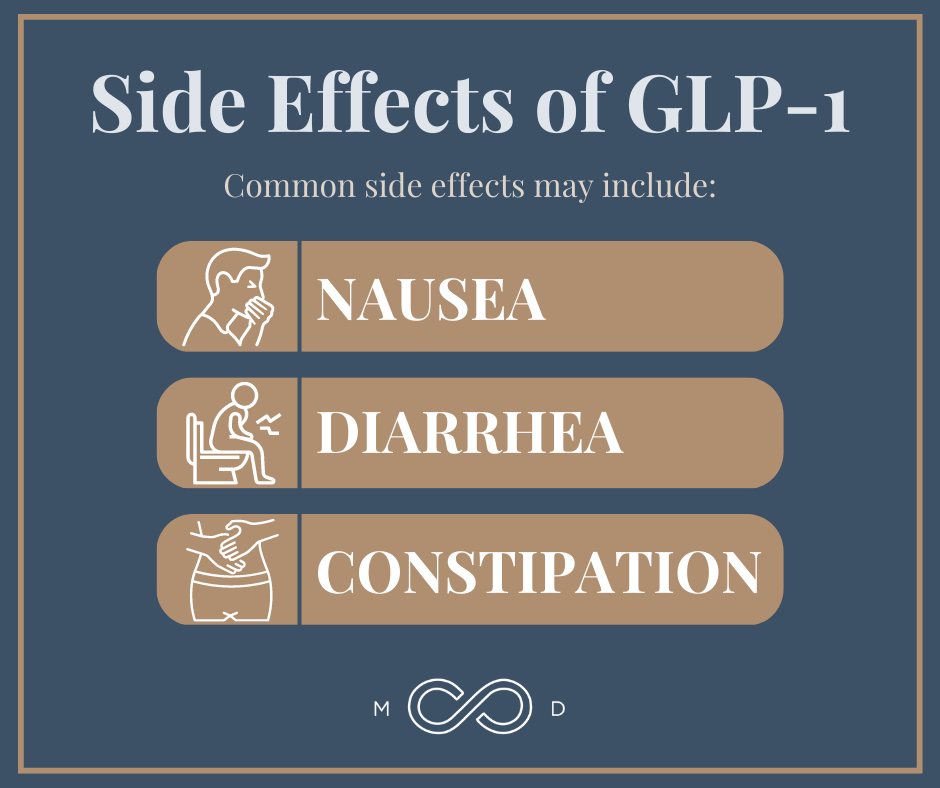If you’ve been watching the news (or your newsfeed) lately, you might have heard about the new pharmaceutical phenomenon sweeping the nation: a diabetes drug for weight loss.
We’ve touched on this type of drug — the GLP-1 agonist — as a tool for weight loss in the past, but now it’s time to really dive in. Here’s what you need to know about this stunningly effective new resource we now have to supplement diet and exercise for weight loss.
Why Take a Diabetes Drug for Weight Loss?
GLP-1 agonists originally appeared as a treatment for people with type 2 diabetes. So how did we get from GLP-1 for diabetes to GLP-1 for weight loss?
Scientists developed GLP-1 agonists as an alternative way for certain diabetic patients to control their blood sugar. And it worked — really well.
But the drugs also produced a side effect as part of the way they operated. Normally, we hear “side effect” and say, “Uh-oh!” But this was an unexpectedly positive side effect — serious weight loss.
New research began into the use of GLP-1 drugs for weight loss, and today we have several FDA-approved options.
How Do GLP-1 Drugs Work?
GLP-1 stands for glucagon-like peptide 1, a hormone released by your gut in response to food. This hormone causes the body to produce more insulin in order to get sugar out of your bloodstream and into your cells. GLP-1 drugs mimic this hormone activity, binding to GLP-1 receptors and stimulating insulin release.
That’s how GLP-1 agonists work to control blood sugar in diabetic patients. An “agonist” increases the effect of something (as opposed to an antagonist, which inhibits an effect). Because we’re now aware of this natural GLP-1 pathway, we can exploit it to give us greater control over our energy management and metabolism.
Beyond just lowering your blood sugar, GLP-1 drugs affect the entire gastrointestinal system — and even the brain — to produce weight loss.
As far as your gastrointestinal system, GLP-1 drugs cause your stomach to empty more slowly, and they reduce the speed at which food runs through your intestines. One of the big benefits here is that you feel fuller for longer. The other is that your body gets more time to digest your food, allowing for more controlled absorption and less of the typical spike in blood sugar after a meal.
GLP-1 injections have an effect on the liver, slowing down your body’s native sugar production. They also increase insulin sensitivity, which we know is the enemy of diabetes at the level of your liver and your skeletal muscles. And in your brain, GLP-1 drugs send signals of satiety, reducing your desire to eat.
GLP-1 agonists are really the first drugs that effectively hit this problem from so many different entry points to achieve the goal of reversing metabolic disease.
My Take on GLP-1 for Weight Loss
One of the most significant contributors to the weight-loss success of GLP-1 agonists is appetite suppression. It’s not that you’re less hungry; you don’t even think about food.
And this creates an enormous opportunity.
How? By creating the space for anyone who struggles with weight loss to reevaluate everything about their eating without having to battle every step of the way.
I’ve seen lifelong weight loss strugglers — people who never felt they could push away a plate or be in control — making changes they’ve always wanted to. And it doesn’t require any energy from them. It’s effortless.
GLP-1 for weight loss creates the runway for behavior modification.
These drugs calm the storm around weight loss. And when people aren’t wrestling with portion control or cravings, they can notice that even though they aren’t eating as much, they still feel okay. After doing that for four to six months and establishing new habits, they can come off the drug and still have those healthy behaviors in place.
We’ve seen other drugs successfully serve as a runway for behavior changes. Ketamine is a dissociative drug. When you take it, you basically have an out-of-body experience. You’re aware of what’s happening to your body, but you’re also detached from the experience, more like an observer.
In certain therapy settings, micro-doses of ketamine can help patients approach traumas that their conscious minds have walled off to keep them safe. They can look at something painful without actually being in, and can then reevaluate the trauma.
GLP-1 injections can have a similar impact for people who historically struggle to maintain a healthy relationship with food.
I like GLP-1 for weight loss because it creates a similar kind of out-of-body experience with eating. It opens the door to a calm, more detached reevaluation of a person’s relationship with food without an active battle raging around them the whole time.
The net result is that people feel in control and safe.
This is where we see massive behavior changes. While people are losing weight, they’re building momentum, feeling positive, and seeing changes in their blood work. They come out on the other end of this journey a healthier, more vibrant version of themselves with a brand new eating strategy they’re already fully acclimated to.
In fact, using GLP-1 for weight loss is a wonderful opportunity to introduce people to fasting — because they’re effectively living out a fasted lifestyle on the drug! Something that seemed impossible before becomes easy. They see that they can do it and how good they feel when fasting. They develop the habit, and it becomes something they can continue even without the drug.
Who Should Consider GLP-1 Injections?
GLP-1 injections are, of course, a remarkable tool for anybody with diabetes, insulin resistance, or metabolic disease. But, as we just talked about, they’re also incredibly useful for anyone who has an unhealthy relationship with food.
If your weight tends to yo-yo up and down, or you just can’t seem to get any consistent momentum with weight loss, then a GLP-1 drug may be a good fit. It offers a security blanket that lets you make the changes you need. Whether that takes a few months or a few years, or even longer, I don’t know — it will depend on the person, and that’s okay.
What I do know is that the only way GLP-1 injections don’t work is if people don’t get their shot once a week.
Are There Any Side Effects?
We’ve found that people generally tolerate GLP-1 for weight loss well, and the side effect profile seems to be fairly mild and predictable.
Because GLP-1 agonists slow down the digestion of food, people typically experience some gastrointestinal side effects — primarily nausea, diarrhea, or constipation. However, these tend to be dose dependent, self limiting, and transient once your body acclimates.
I do get a little concerned that we’re so early in the use of GLP-1 drugs, and that they’re getting so much praise. Right now, we’re blind to any unseen downsides that haven’t been discovered yet.
So while I’m still enthusiastic about the help these drugs can provide to so many people, the scientist in me knows everything in life has risk. We’re a few years in, but it usually takes about 20 years of patient data to fully understand the true risk of a drug.
That said, there’s a lot of attention on GLP-1 agonists for weight loss and diabetes, which means there’s going to be a lot of funding for research. We can pay attention to these studies as they roll out.
Right now, GLP-1 for weight loss is very promising. We haven’t had a medicine to deal with a problem this big — and with such significantly positive results — maybe ever.
How Much Does GLP-1 for Weight Loss Cost?
The biggest difficulty most people will encounter today with GLP-1 drugs is going to be the cost.
Because insurance companies view diabetes as an illness, they often cover GLP-agonists to treat it. Sadly, they don’t typically take the same view toward GLP-1 for weight loss.
If you’re lucky enough to have insurance cover GLP-1 injections, that’s amazing. But if your insurance doesn’t cover it, I’m seeing prices as high as $1,800 for a month’s supply of brand name medication.
The good news is you can now get generic versions of GLP-1 agonists, and your local compounding pharmacy should have access to the generic version of Ozempic, called semaglutide. That might be $200–$300 a month, so still not an insignificant investment, but much closer to the realm of possible.
Final Thoughts on GLP-1 for Weight Loss
It’s always encouraging when something comes out of the gate this widely used and — up to this point — still looks widely safe. But the reality is the scientific process takes time. It takes time to get a firm grasp of the true risk profile of a drug.
So that’s something to keep in the back of your mind. Don’t blindly keep taking it without staying up to date with the research. Keep your eyes open. Stay alert.
With that said, I’m cautiously optimistic we’re going to find that all our data supports the early evidence. There’s enough experiential clinical data that I’m willing and able to go on record as being bullish about GLP-1 for weight loss.
If you’ve read this blog or heard my podcast before, you know I’m not a drug pusher. And despite all GLP-1 agonists can do, there’s no silver bullet for weight loss. This can’t replace long-term dietary modifications and a lifelong commitment to fitness.
HOWEVER, this really is a game changer for those who are in the fight for weight loss and haven’t had quite the winning record they deserve. Combined with a strategic diet and exercise plan, GLP-1 for weight loss could be the thing that unlocks you in your weight loss journey.

Dr. Aaron Wenzel is a concierge physician specializing in the care of fast-moving entrepreneurs, executives, and public figures in the Nashville, TN area. Dr. Wenzel’s diverse life experience and extensive training in family medicine, emergency care, nutrition, and hormone replacement therapies give him the unique platform to provide unmatched care for his patients.








